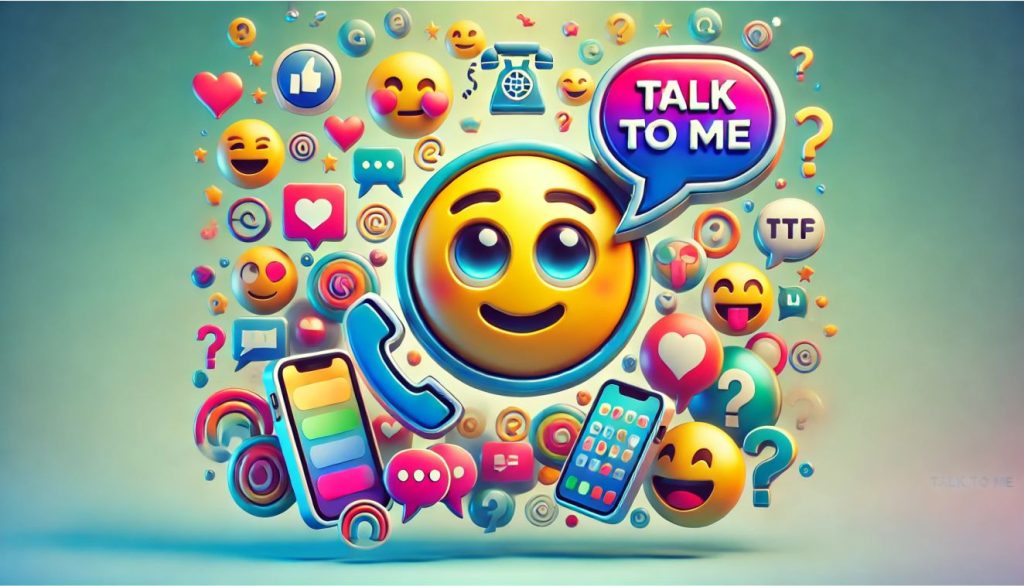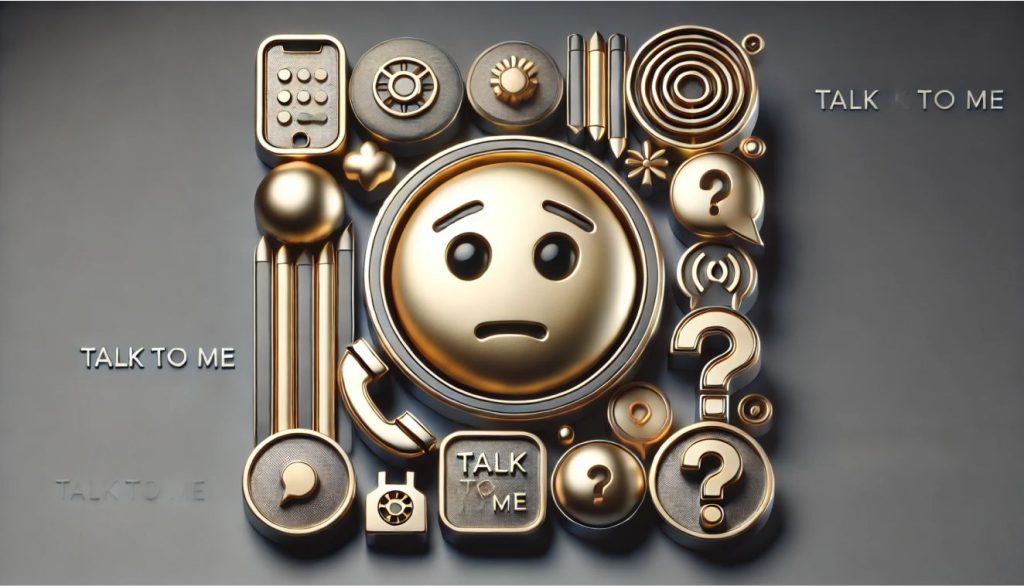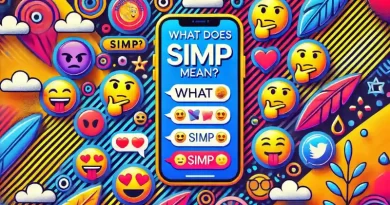Descodificación de TTM en mensajes de texto
Centrémonos ahora en "TTM". Este acrónimo ha ganado popularidad en la mensajería de texto y la comunicación en línea, pero ¿qué significa? "TTM" representa comúnmente la frase "Talk To Me" (Háblame). Es una invitación, una llamada a la conversación, una extensión de la mano digital, por así decirlo. Cuando alguien utiliza "TTM" en un mensaje, básicamente está diciendo: "Estoy aquí, y estoy listo para charlar. Hablemos".
What does TTM mean?
Variaciones comunes de "TTM
While the core meaning remains “Talk To Me,” the context in which it’s used can modify its interpretation. Here are a few common variations and their explanations:
Variación | Significado |
T2M | Una forma abreviada de "Talk To Me". |
T2U | Una petición para que alguien "Hable Contigo". |
T2P | Una invitación para "Hablar con la gente" o chatear en grupo. |
TTM2B | Sugiere que el individuo está disponible y desea que los demás inicien una conversación con él. |
TTMNA | Implica que alguien tiene ganas de hablar, pero "no hay nadie". |
TTMK | Puede ser una forma de decir "Háblame luego". |
| TTM | Los niños a veces usan TTM para significar 'Habla Demasiado'. ¡Por ejemplo, "YOU TTM! |
Variaciones comunes de "TTM
Like many texting abbreviations, “TTM” may have variations and nuances in its usage. While the core meaning remains “Talk To Me,” the context in which it’s used may modify its interpretation. Here are a few common variations and explanations:
T2M: A shortened form of “Talk To Me.”
T2U: A request for someone to “Talk To You.”
T2P: An invitation to “Talk To People” or chat in a group setting.
TTM2B: Suggests that the individual is available and wants others to initiate conversation with them.
TTMNA: Implies that someone is eager to talk, but “no one’s around.”
TTMK: It could be a way of saying “Talk To Me Later.”
TTM: Sometimes used by kids to mean “Talk Too Much.” Example: “YOU TTM!”
The variations showcase the adaptability of “TTM” in various conversation contexts, ranging from one-on-one discussions to group interactions. Additionally, the usage of ‘TTM’ can also vary across other platforms like Instagram and TikTok.
Cómo se utiliza "TTM
Now that we’ve deciphered the meaning of “TTM” let’s explore its practical usage in text messaging. “TTM” is a versatile expression that may be deployed in a variety of situations:
Initiating a Conversation: The most straightforward use of “TTM” is to start a conversation. When you send “TTM” to someone, you’re expressing your readiness to engage in a chat.
Expressing Availability: “TTM” is also used to let others know that you’re available for communication. It’s a way of saying, “I’m here, and I’m open to talking.”
En busca del compromiso: If you’re in a group chat and want to get everyone talking, sending “TTM2B” may be a subtle way of encouraging others to join the conversation.
Indicating a Desire for Communication: “TTMNA” implies that you’re eager to talk but currently don’t have anyone to chat with. It’s a way of expressing your openness to conversation when someone becomes available.
Suggesting a Delayed Conversation: If you’re currently occupied or can’t chat at the moment, you might use “TTMK” to indicate that you’d like to talk later.
Ejemplos de "TTM" en los mensajes de texto
Let’s break down some examples of how “TTM” lights up our digital conversations.
In many cases, ‘TTM’ can often replace an entire sentence, making communication more efficient.
Conversaciones personales
In personal chats, “TTM” adds a friendly, informal touch. It’s like waving someone over to your digital space for a chit-chat. On Instagram, ‘TTM’ is also commonly used in personal chats to foster engagement.
Ejemplo: Ponerse al día con los amigos
Text: “Hey! Long time no see, TTM 😊”
Context: Reconnecting with a friend, inviting them to share updates.
Ejemplo: Hacer planes
Text: “TTM about the weekend plans 📅👍”
Context: Discussing upcoming events or outings with friends.
Contexto profesional
Even in a professional setting, “TTM” may sneak in, especially in less formal, internal communications. In financial discussions, ‘TTM’ can also stand for ‘Through the Mail,’ referring to documentation or communication methods regarding a company’s past performance.
Ejemplo: Colaboración en el trabajo
Text: “Got a minute? TTM about the project update. 📈”
Context: Requesting a quick chat about work-related matters.
Ejemplo: Programación de reuniones
Text: “Can you TTM tomorrow for the team meeting? 🗓️”
Context: Arranging or confirming a meeting time.
Uso romántico o coqueto
In a more intimate setting, “TTM” becomes a coy invite, sparking private conversations.
Ejemplo: Iniciar una conversación
Text: “Hey, TTM? I’ve been thinking about you 😏”
Context: Initiating a flirtatious chat with romantic interest.
Ejemplo: Profundizar la conexión
Text: “Miss you, TTM tonight? 🌙💬”
Context: Seeking a more personal, heartfelt conversation.
Interpretaciones de "TTM
The beauty of text messaging lies in its flexibility and the potential for multiple interpretations. “TTM” is no exception. Depending on the context and the relationship between the sender and recipient, the meaning of “TTM” may vary. Understanding ‘TTM’ is crucial across various social media platforms like Instagram and TikTok.
Friendly Invitation: In a casual conversation with friends or family, TTM often carries a friendly tone. It’s an open door for discussion, indicating that you’re approachable and eager to chat.
Comunicación empresarial o profesional: It could also be used in professional settings to express your availability for work-related discussions. In such cases, it signifies your readiness to engage in a conversation, whether it’s for a business meeting or a work-related project.
Romantic or Flirtatious Use: In a more intimate context, “TTM” may take on a flirtatious undertone. It signals a desire for one-on-one, private communication.
Group Conversations: In group chats, it may serve as a prompt to get everyone talking. It encourages group members to share thoughts and engage in the conversation.
Cultura pop y "TTM
As texting has become deeply ingrained in our daily lives, it’s no surprise that texting slang, including “TTM,” has found its way into popular culture. You might encounter “TTM” in various forms of entertainment, such as movies, TV shows, and music. In such contexts, it’s used to depict characters engaging in text-based conversations and reflects the modern way people communicate.
For instance, a character in a TV show might dramatically send a “TTM” message to a love interest to convey a longing for connection, adding a layer of intrigue to the storyline. In songs, “TTM” may be incorporated into lyrics, further solidifying its place in contemporary culture.
Beyond explicit uses, “TTM” has permeated social media and internet culture, becoming a symbol of digital connection in the 21st century. For more information on texting abbreviations and their meanings, you can visit our dedicated page.
Ejemplos personales del uso de "TTM" con Emojis
Texting is an art, and when you blend the succinct charm of “TTM” with the expressive power of emojis, you create digital masterpieces of conversation. Check out the following examples below:
Chat amistoso: “TTM, what’s up? 😄” — Uses the Smiling Face Emoji to initiate a light-hearted conversation.
En busca de consejo: “Can you TTM? Need some advice 🤔” — Uses the Thinking Emoji to ask for guidance or suggestions.
Interacción de grupo: “Everyone, TTM in the group chat! 🗣️👥” — Uses the Speaking Head and People Emojis to encourage group discussion.
Después de una cita: “Had a great time! TTM again soon? 💑” — Uses the Couple with Heart Emoji to express interest in further communication post-date.
Seguimiento del trabajo: “About the client feedback, TTM pls 📊” — Uses the Bar Chart Emoji to discuss professional matters.
Consolar a un amigo: “TTM if you need to talk, I’m here 🤗” — Uses the Hugging Face Emoji to offer support during tough times.
Compartir la emoción: “TTM about the concert details! 🎶🎉” — Uses the Musical Notes and Party Popper Emojis to discuss an exciting event or plan.
When Not to Use the TTM Acronym
There are certain situations where TTM may not be appropriate. Here are guidelines to keep in mind:
1. Formal Settings: TTM is generally considered informal and casual. Avoid using it in professional or formal settings, such as business emails or official communications.
2. Serious Conversations: If you’re discussing a sensitive or serious topic, it’s best to avoid using TTM. Stick to using full words and phrases to convey your message clearly and respectfully.
3. Older Generations: While TTM is widely used among younger generations, it may not be familiar to older individuals. If you’re communicating with someone who is not as tech-savvy, it’s best to avoid using abbreviations that they may not understand.
4. International Communication: When texting with someone from a different culture or country, it’s important to be mindful of language barriers and cultural differences. TTM may not be universally understood, so it’s best to avoid using it in international communication unless you’re sure the other person is familiar with texting abbreviations.
5. Sensitive Topics: If you’re discussing a sensitive or serious topic, it’s best to avoid using TTM. Stick to using full words and phrases to guarantee your message is understood and taken seriously.
Ejemplos personales del uso de "TTM" con Emojis
En resumen, enviar mensajes de texto es un arte, y cuando combinas el encanto sucinto de "TTM" con el poder expresivo de los emojis, creas obras maestras digitales de la conversación. Esta sección muestra cómo "TTM" puede integrarse en varios escenarios de mensajes de texto, cada uno de ellos mejorado con emojis para transmitir emociones e intenciones de forma más vívida. Desde ponerse al día con los amigos hasta los contactos profesionales, descubre cómo "TTM" adquiere diferentes tonos y significados en el mundo de los mensajes de texto.
| Escenario | Ejemplo de texto | Emojis utilizados | Contexto |
|---|---|---|---|
| Chat amistoso | "TTM, ¿qué pasa? 😄" | Emoji de cara sonriente | Iniciar una conversación desenfadada |
| En busca de consejo | "¿Se puede TTM? Necesito un consejo 🤔" | Emoji pensativo | Pedir orientación o sugerencias |
| Interacción de grupo | "¡Todos, TTM en el chat del grupo! 🗣️👥" | Emoji de cabeza y personas que hablan | Fomentar el debate en grupo |
| Después de una cita | "Me lo he pasado muy bien. TTM de nuevo pronto? 💑" | Emoji de pareja con corazón | Expresar interés en una comunicación posterior a la fecha |
| Seguimiento del trabajo | "Sobre los comentarios de los clientes, TTM pls 📊" | Emoji de gráfico de barras | Discutir asuntos profesionales |
| Consolar a un amigo | "TTM si necesitas hablar, estoy aquí 🤗" | Emoji de cara abrazada | Ofrecer apoyo en los momentos difíciles |
| Compartir la emoción | "¡TTM sobre los detalles del concierto! 🎶🎉" | Emoji de notas musicales y Party Popper | Hablar de un acontecimiento o plan emocionante |
Y ahí lo tienen, amigos. Una vívida muestra de cómo "TTM", combinado con los emojis perfectos, puede añadir dinamismo y claridad a tus mensajes. Ya sea una sonrisa, un gesto considerado o una explosión de emoción, el emoji adecuado puede convertir un simple "Talk To Me" en el inicio de una conversación.
Preguntas y respuestas frecuentes
En los mensajes de texto, "TTM" significa "Talk To Me" (Háblame). Se utiliza como invitación a la conversación, indicando que el remitente está abierto y dispuesto a charlar.
"TTM" se utiliza habitualmente para iniciar una conversación, expresar disponibilidad para chatear o como empujón amistoso para animar a alguien a comunicarse.
Cuando un chico envía un mensaje de texto "TTM", normalmente significa que está invitando a una conversación o mostrando interés en comunicarse. Puede ser amistoso, coqueto o simplemente una forma de iniciar un diálogo.
Si una chica envía "TTM", suele indicar su deseo de entablar una conversación. Puede sugerir simpatía, apertura al chat o interés por la persona a la que envía el mensaje.
Existen variaciones como "T2M", "T2U", "T2P", "TTM2B", "TTMNA" y "TTMK", cada una con significados ligeramente diferentes pero centradas en el tema de la comunicación.








